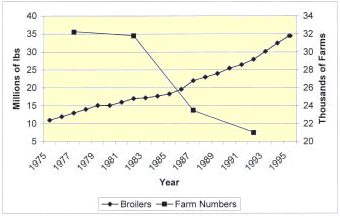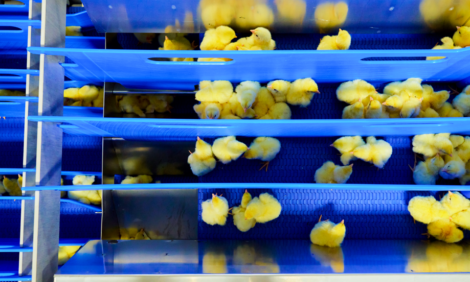



Shelterbelts: Has Their Time Come ?
By G.T. Tabler, Poultry Science Department at the University of Arkansas's Avian Advice - The increasing urban expansion into rural areas creates numerous challenges for livestock producers to various types of farming operations. A strong livestock industry is essential to the nation’s economic stability, the viability of many small rural communities, and the sustainability of a healthful, plentiful and high quality food supply for the American public.Introduction
Farmers and
ranchers view odors and dust associated with
livestock as part of production agriculture and
have come to accept them as part of their way
of life. However, as urban dwellers are less
likely to accept dust or odors, differences in
lifestyles between farmers and city folks are
becoming increasingly apparent. Although
there will probably always be some odor and
dust issues associated with animal production
units, there are some simple, economical
methods of reducing the frequency of
complaints.
For poultry producers, shelterbelts offer
an opportunity for poultry growers to be
proactive in demonstrating good neighbor
relations and environmental stewardship.
Shelterbelts are typically vegetation (most
often trees and shrubs) planted in purposeful
rows to alter wind flow in order to achieve
certain objectives. Planting trees and shrubs
as screens around poultry houses will help
remove them from public view (perhaps also
the public’s mind) and buffer odor, dust and
noise.
Livestock Production
In the United States about 130 times more
animal waste is produced annually than
human waste. Livestock in the U.S. produce
more than 1.4 billion tons of manure annually
(U.S. Senate Committee, 1997). Livestock
production in the U.S. is characterized by
fewer yet much larger production facilities.
USDA data indicate that nationwide about
85% of estimated 450,000 agricultural
operations with confined animals have fewer
than 250 animal units (GAO, 1995).
Therefore, only about 15% of farms
house the vast majority of the animal units
nationwide. USDA estimates that only about
6,600 animal feeding operations nationwide
have more than 1,000 animal units (GAO,
1995). From 1978-1992, the average number
of animal units per facility increased by 56,
93, 134, 176, 148 and 129% for cattle, hogs,
layers, broiler and turkeys, respectively, while
during the same period the number of
facilities dropped by over 40% in the cattle
industry, and over 50% in the dairy, hogs and
poultry industries (USDA and EPA, 1999).
Figure 1 demonstrates the increase in broiler
production and decrease in broiler farm
numbers from 1975 to 1995. Increased size
of production facilities and greater numbers
of livestock at each facility has meant larger
amounts of animal waste, concentrated into
relatively smaller geographic areas. This
concentration of animals has increased the intensity, duration, and timing of odor events. The control of livestock odors has become of paramount concern for the public and
livestock producers.
Figure 1: US Broiler production (lbs) and number of farms 1975 - 1995 Source: United States Senate Committee on Agriculture, Nutrition and Forestry, 1997 |
Understanding Odor Events
A recent survey of Iowa farmers found that 46% of rural residents were within a half mile or less of a livestock facility. In the same survey 71% of residents were within one mile of a livestock facility (Lasley and Larson, 1998). This finding is consistent with the average separation distances nationwide (Tyndall and Colletti, 2000). Odor compounds may be transmitted as gases, aerosols (a suspension of relatively small solid or liquid particles in gas) or dust (relatively large particles in gas or air). Efforts to control odors from animal production units fall into three basic strategies (Tyndall and Colletti, 2000):
- Prevent odors from forming
- Capture or destroy odorous compounds and
- Collection, dispersion or dilution of odor compound.
In most cases the third strategy is the easiest and most economical procedure to implement in animal production units. In operations without protection wind or breezes often transmit odors gases, aerosols and dust to neighbors. Shelterbelts hinder this transmission, by trapping odors, redirecting air or creating turbulence so that odor compounds are diluted.
Odor Control using Shelterbelts
The source of animal odors is near the ground and tends to
travel along the ground (Takle, 1983), shelterbelts can
intercept and disrupt the transmission of these odors (Heisler
and DeWalle, 1988; Thernelius, 1997). Shelterbelts also
reduce the release of dust and aerosols by reducing wind speed
near production facilities. Wind tunnel modeling of a threerow
shelterbelt quantified reductions of 35% to 56% in the
downwind transport of dust. However, shelterbelt density
determines the degree to which dust and aerosols are reduced.
Density is a simple ratio of the porous area (the areas wind can
pass through) to the total area of the shelterbelt. A density of
approximately 40-60% is the most beneficial (Brandle and
Finch, 1991). The trees or shrubs chosen for the shelterbelt
and the spacing of those plants will determine the overall
density. Remember that deciduous species tend to be more
open closer to the ground and conifers have branch cover
close to the ground (Griffith, 2001).
Shelterbelts physically also intercept dust and other
aerosols. A forest cleans the air of micro-particles twenty-fold
better than barren land. Leaves with complex shapes and large
circumference to area ratios collect particles most efficiently.
Shelterbelts attract and bind the chemical constituents of odor.
Volatile Organic Compounds (VOCs) have an affinity to the
cuticle of plant leaves. Microorganisms on plant surfaces can
metabolize and breakdown VOCs.
Finally, shelterbelts provide a visual and aesthetic screen.
A well-landscaped livestock operation is much more
acceptable to the public than one that is not. Shelterbelts
should be designed for the specific location, according to the
expected and experienced odors, so that the tree and shrub
species chosen can provide year round interception of odors
and aerosols (Griffith, 2001).
Why Shelterbelts Now
Although shelterbelts have been used for many years in
the Midwest to modify wind flow; control wind erosion,
increase crop yields, protect farm buildings, and protect
livestock, few in poultry producing areas considered their use.
However, urban encroachment is forcing changes in how
poultry growers manage their operations and tunnel ventilated
houses have made the use of shelterbelts feasible. Few
recommended planting trees around poultry facilities for fear
of blocking air flow through conventionally-ventilated houses,
but today, with the poultry industry shifting to tunnelventilated,
solid sidewall poultry houses, restricting natural air
flow is much less of a problem.
Trees have a pleasing image across a large cross section of
the American population. Planting trees around poultry
houses may help foster a positive image of your farming
operation. In addition, as the trees mature, less of your
agricultural operation will attract attention, your farm takes on
a more attractively landscaped appearance, and property
values increase for both you and your neighbors (Malone and
Abbott-Donnelly, 2001).
Plants used in Shelterbelts
Dense evergreen trees are perhaps the best choice for the
tunnel fan end for maximum filtering during summer and
screening year round. For greatest emissions scrubbing,
shelterbelts should be as close to the tunnel exhaust as
possible. As a general rule, to not interfere with fan
efficiency, no trees should be planted closer than a distance of
five times the diameter of the fans (Malone and Abbott-
Donnelly, 2001). Check with your integrator before
constructing a shelterbelt. Take into account the width of the
shelterbelt at maturity and how this may affect roads, loadout
areas, or chick delivery areas.
There are a variety of trees and shrubs suitable for
Arkansas conditions that would work well to screen poultry
houses. White pine, properly spaced, creates a dense
shelterbelt, grows rapidly and is reasonably priced. Virginia
pine and loblolly pine also do well. Various cedars also form
a dense mat; however, some consider certain varieties a
nuisance and the berries may attract wild birds. A variety of
hollies and other ornamental shrubs such as Red Tip Photinia
form highly effective screens and have a beautifying effect on
the surrounding landscape. The plants you choose will depend
on the site, soil conditions, available space, number of plants
required, growth rate of plants, personal preference for
landscaping effects and cost of the plants. For more
information on trees and plants that do well in your area,
contact your local county Extension office, local Conservation
District, Arkansas Forestry Commission or a professional
landscape nursery/garden center.
Air quality issues surrounding poultry production facilities
are no longer a matter of “if”, but “when.” Arkansas poultry
producers should take proactive steps to plan for management
changes these issues will bring. The planting of trees in
strategic locations around poultry houses is one method to
help address these issues before and as they arise. In addition,
research has shown that shelterbelts can reduce heating costs
10-40% and reduce cooling costs as much as 20%.
Strategically placed trees can also reduce wind speeds by
50%, adding protection from spring and fall storms. The
leaves of trees physically trap dust particles that may be laden
with nitrogen, and root systems will absorb up to 80% of the
nutrients that might escape the proximity of the poultry
operation (Stephens, 2003). Cost-share assistance for planting
a shelterbelt is available in some states; unfortunately,
Arkansas is not one of these states at the present time.
Barriers to Shelterbelt Adoption
Although shelterbelts around the perimeter of poultry houses offer many advantages, there are some barriers to adoption and some negative aspects to consider. For example, Malone and Abbott-Donnelly (2001) indicate:
A limited amount of land will be taken out of production to support the shelterbelt
There will be cost associated with purchasing the trees, labor for planting and maintenance
You will encounter a restricted view of your houses access will be limited to designated roadways trees will create a potential habitat for wild birds.
Summary
Air quality issues will become an increasing concern to
production agriculture with continued urban encroachment
into previously rural, agricultural areas. Shelterbelts offer one
method by which poultry producers can take proactive steps to
address the issue; demonstrating good public relations efforts
and environmental stewardship by buffering odor, dust and
noise emissions from their facilities while improving farm
aesthetics and property values.
Dense shelterbelts may detract
attention from farming operations and help reduce air
emission concerns surrounding poultry facilities by capturing
dust particles and ameliorating odors. Consult your integrator
concerning placement before constructing a shelterbelt. Select
trees or shrubs suitable for your area. Your local Extension
office, NRCS office, Arkansas Forestry Commission or local
landscape nursery can be of valuable assistance on species
information. If planted during warmer weather, be sure to
provide plenty of water to assure successful establishment. A
well-landscaped livestock operation is more pleasing to the
public than one that is not.
A shelterbelt used as a pollution
control device is visible proof that producers are making an
effort to control what leaves their operation. This could prove
valuable in the court of public opinion and perhaps reduce
tension levels between farming and non-farming segments of
the population.
References
Brandle, J. R., and S. Finch. 1991. How windbreaks work.
University of Nebraska Cooperative Extension Publication
EC91-1763-B.
General Accounting Office (GAO). 1995. Animal
Agriculture: Information on Waste Management and Water
Quality Issues.
Griffith, C. 2001. Improvement of air and water quality
around livestock confinement areas through the use of
shelterbelts. South Dakota Association of Conservation
Districts.
Hammond, E. G., C. Fedler, and R. J. Smith. 1981.
Analysis of particle bourne swine house odors. Agriculture
and Environment. 6:395-401.
Heisler, G. M., and D. R. Dewalle. 1988. Effects of windbreak structure on wind flow. Elsevier Science Publishers B.V.,
Amsterdam. Agriculture, Ecosystems and Environment, 22/23:41-69.
Laskley, P. and K. Larson. 1998. Iowa farm and rural life poll – 1998 Summary Report. Iowa State University Extension, Pm-
1764, July, 1998
Malone, G. W., and Abbott-Donnelly, D. 2001. The benefits of planting trees around poultry houses. University of Delaware
College of Agriculture and Natural Resources. Bulletin #159. 4 pages.
Stephens, M. F. 2003. Benefits of trees on poultry farms. The Litter Letter. Fall 2003. LSU Ag Center Research and Extension,
Cooperative Extension Service. Calhoun, La.
Takle, E. S. 1983. Climatology of superadiabatic conditions for a rural area. J. Climate and Applied Meteorology. 22:1129-
1132.
Thernelius, S. M. 1997. Wind tunnel testing of odor transportation from swine production facilities. M. S. Thesis. Iowa State
University, Ames.
Tyndall, J., and J. Colletti. No Date . Odor Mitigation. Available at: http://www.forestry.iastate.edu/res/odor_mitigation.html.
6 pages.
Tyndall, J., and J. Colletti. 2000. Air quality and shelterbelts: Odor mitigation and livestock production a literature review.

Source: Avian Advice - Winter 2004 - Volume 6, Number 2









